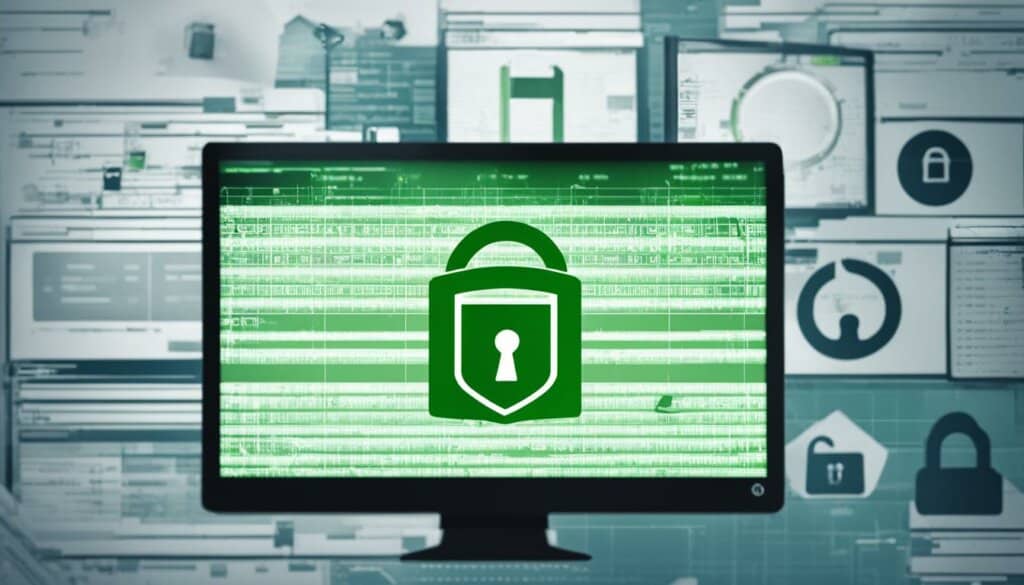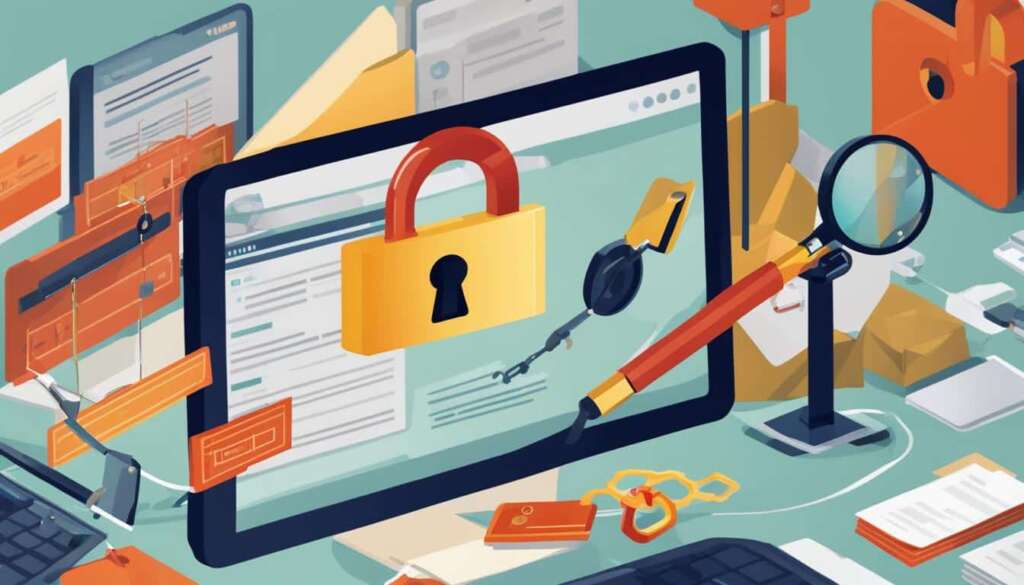Table of Contents
In today’s fast-paced digital landscape, conducting cybersecurity audits is of utmost importance to safeguard businesses against evolving cyber threats. Regular audits assess compliance, identify vulnerabilities, and provide solutions to strengthen an organization’s defenses. By conducting cybersecurity audits, businesses can stay proactive in protecting sensitive data, avoiding fines, and enhancing their digital security posture.
With the increasing frequency and sophistication of cyber attacks, businesses cannot afford to overlook the importance of cybersecurity audits. These audits evaluate an organization’s IT practices, assess security systems, and uncover weak areas that need attention. By identifying vulnerabilities such as careless employees, phishing attacks, insider threats, DDoS breaches, IoT devices, and malware, cybersecurity audits help businesses take the necessary steps to mitigate risks and strengthen their overall security.
What is a Cybersecurity Audit?
A cybersecurity audit is an essential process that organizations undergo to assess the effectiveness of their security measures and identify potential vulnerabilities. It involves evaluating compliance with industry standards, assessing security practices, and determining the organization’s overall cybersecurity posture. Conducting regular cybersecurity audits is a critical aspect of cybersecurity risk management, as it helps organizations proactively identify and address potential threats.
During a cybersecurity audit, various aspects of an organization’s digital infrastructure are examined. This includes evaluating the effectiveness of access controls, data encryption, network security, incident response plans, and employee training programs. The audit process may involve reviewing policies and procedures, conducting vulnerability assessments, performing penetration testing, and analyzing security logs.
The primary objectives of a cybersecurity audit include:
- Identifying vulnerabilities and weaknesses in the organization’s security systems
- Evaluating compliance with relevant regulations and industry standards
- Assessing the effectiveness of security controls and measures
- Providing recommendations to strengthen the organization’s cybersecurity defenses
“A cybersecurity audit is like a health check-up for an organization’s digital infrastructure. It helps identify potential risks and weaknesses so that appropriate measures can be taken to mitigate them.” – Cybersecurity Expert
By conducting regular cybersecurity audits, organizations can ensure that their digital assets are protected and that they remain resilient against evolving cyber threats. These audits provide valuable insights into the organization’s security posture and help identify areas for improvement, enabling proactive risk management and enhancing overall cybersecurity resilience.
Benefits of Conducting a Cybersecurity Audit
A cybersecurity audit offers numerous benefits that help organizations enhance their IT security measures, ensure regulatory compliance, and strengthen their overall cybersecurity posture. Some of the key advantages of conducting a cybersecurity audit include:
1. Identification of Vulnerabilities
One of the primary benefits of a cybersecurity audit is the identification of vulnerabilities within an organization’s information systems. Through a comprehensive assessment, auditors can pinpoint weak areas and potential entry points for cyber threats. By understanding these vulnerabilities, organizations can take proactive measures to strengthen their security defenses and mitigate the risk of a breach or unauthorized access.
2. Enhanced Protection Measures
A cybersecurity audit helps organizations review and assess their existing protection measures, including network security, data encryption, access controls, and incident response protocols. By analyzing these measures, auditors can provide recommendations for improving security mechanisms, implementing robust controls, and ensuring that sensitive information remains secure. This enables organizations to stay one step ahead of cybercriminals and minimize the potential impact of a security incident.
3. Regulatory Compliance
Compliance with industry standards and regulations is a critical aspect of cybersecurity. A cybersecurity audit helps organizations evaluate their adherence to relevant compliance requirements and identify any gaps or non-compliance issues. By addressing these gaps and implementing the necessary controls, organizations can ensure that they meet the prescribed regulatory standards and avoid penalties or legal ramifications.
4. Incident Response Preparedness
Another benefit of conducting a cybersecurity audit is the evaluation of an organization’s incident response capabilities. Auditors assess the effectiveness of incident response plans, test the organization’s ability to detect and respond to security incidents, and identify areas for improvement. This enables organizations to enhance their incident response processes and ensure that they are well-prepared to mitigate and recover from any cybersecurity incidents effectively.
In conclusion, a cybersecurity audit offers significant advantages for organizations seeking to protect their digital assets, maintain regulatory compliance, and enhance their incident response capabilities. By identifying vulnerabilities, improving protection measures, ensuring compliance, and strengthening incident response preparedness, organizations can strengthen their overall cybersecurity defenses and proactively address potential security risks.
Internal vs. External Auditing: What’s the Difference?
When it comes to cybersecurity audits, organizations have the option to choose between internal and external auditing. Each approach has its own advantages and considerations, making it important to understand the difference between the two.
Internal Auditing
Internal auditing involves conducting cybersecurity audits using in-house resources and expertise. This approach offers several benefits, including cost-effectiveness and ease of management. Since the auditors are familiar with the organization’s systems and processes, they can quickly identify potential vulnerabilities and weaknesses. However, it’s important to consider the potential for bias in internal audits, as auditors may be influenced by personal opinions or departmental interests. To mitigate this, organizations can implement strict protocols and independence measures to ensure objectivity and comprehensive evaluations.
External Auditing
External auditing, on the other hand, involves hiring third-party vendors or cybersecurity audit services to assess an organization’s security posture. These external auditors bring specialized expertise, tools, and industry knowledge to the table. They can provide an unbiased perspective and offer a fresh set of eyes to identify vulnerabilities and recommend best practices. While external auditing may come at a higher cost, it offers the advantage of expertise and independent evaluation that can greatly enhance an organization’s cybersecurity defenses. It’s important to note that external audits are typically recommended on an annual basis.
| Internal Auditing | External Auditing |
|---|---|
| Conducted by in-house resources | Conducted by third-party vendors |
| Cost-effective | Higher cost |
| Familiarity with organization’s systems | Specialized expertise and industry knowledge |
| Potential for bias | Unbiased perspective |
| Recommended frequency: Quarterly | Recommended frequency: Annually |
Best Practices for a Cybersecurity Audit
A cybersecurity audit is an essential process for organizations to evaluate and enhance their digital security measures. By following best practices, businesses can ensure a thorough and effective audit that identifies vulnerabilities and strengthens their cybersecurity defenses. Here are some key practices to consider:
1. Review Data Security Policies
Start by reviewing and updating your organization’s data security policies. This includes documenting policies related to data classification, access controls, data retention, encryption, and incident response. Ensure that these policies align with industry standards and regulations relevant to your business.
2. Centralize Cybersecurity and Compliance Policies
Consolidating your cybersecurity and compliance policies into a centralized document or system helps streamline the audit process. This centralization ensures that all stakeholders have access to the most up-to-date policies and procedures and enables efficient monitoring and enforcement of security measures.
3. Detail the Network Structure
Provide auditors with a comprehensive overview of your organization’s network structure, including information on servers, firewalls, routers, switches, and other network devices. This documentation helps auditors understand the interconnectedness of your systems and identify potential weak points that could be exploited by cyber threats.
4. Review Relevant Compliance Standards
Stay informed about the latest compliance standards and regulations that apply to your industry. Regularly review these standards to ensure your organization remains in compliance. This includes standards such as the General Data Protection Regulation (GDPR), Payment Card Industry Data Security Standard (PCI DSS), and Health Insurance Portability and Accountability Act (HIPAA), among others.
5. Create a List of Security Personnel and Their Responsibilities
Document the roles and responsibilities of your security personnel, including the individuals responsible for managing and monitoring your organization’s cybersecurity measures. This list ensures clarity in accountability and helps auditors understand your organization’s internal procedures and personnel structure.

| Best Practices | Description |
|---|---|
| Review Data Security Policies | Assess and update data security policies to align with industry standards and regulations. |
| Centralize Cybersecurity and Compliance Policies | Consolidate policies into a centralized system for easy access and enforcement. |
| Detail the Network Structure | Provide a comprehensive overview of your network infrastructure to identify weak points. |
| Review Relevant Compliance Standards | Stay up-to-date with industry regulations and ensure compliance. |
| Create a List of Security Personnel and Their Responsibilities | Document roles and responsibilities of security personnel for auditors’ understanding. |
Following these best practices for a cybersecurity audit can help organizations identify vulnerabilities, improve protection measures, and ensure compliance with industry standards and regulations. By maintaining a proactive approach to cybersecurity, businesses can enhance their digital security posture and mitigate the risk of cyber threats.
How Often Should Agencies Audit Their Cybersecurity?
Regular cybersecurity audits are crucial for agencies to maintain a strong defense against evolving cyber threats. It is recommended that agencies conduct cybersecurity audits at least once a year to ensure that security guidelines are followed and vulnerabilities are addressed. However, the frequency of audits may vary depending on several factors.
Several factors can influence the frequency of cybersecurity audits. One important factor is the agency’s budget. Conducting audits can be resource-intensive, so agencies must allocate sufficient funding to support regular audits. Additionally, recent system changes, such as infrastructure upgrades or software implementations, may necessitate more frequent audits to ensure the security measures are appropriate for the new environment.
Compliance standards also play a role in determining the frequency of cybersecurity audits. If an agency operates in a highly regulated industry, they may be required to conduct audits more frequently to ensure ongoing compliance. Furthermore, agencies should consider the ever-changing landscape of cybersecurity risks. If there is a significant increase in cyber threats or if the agency’s risk profile changes, more frequent audits may be necessary to evaluate and mitigate these risks.
| Factors Influencing Audit Frequency | Recommended Audit Frequency |
|---|---|
| Budget | At least once a year |
| Recent system changes | As needed, but at least once a year |
| Compliance standards | As required by regulations, but at least once a year |
| Cybersecurity risks | As needed, but at least once a year |
In addition to regular cybersecurity audits, agencies should also consider conducting cybersecurity risk assessments. These assessments provide a comprehensive evaluation of an agency’s IT security protections and their ability to identify and remediate vulnerabilities. By conducting regular risk assessments, agencies can gain valuable insights into their overall cybersecurity posture and make informed decisions regarding their security measures.
Key Points:
- Agencies should conduct cybersecurity audits at least once a year.
- The frequency of audits may vary depending on factors such as budget, recent system changes, compliance standards, and cybersecurity risks.
- Cybersecurity risk assessments should also be conducted regularly to evaluate an agency’s overall security posture.
Tips for a Cybersecurity Audit
When preparing for a cybersecurity audit, there are several key tips that can help organizations ensure a thorough and effective evaluation of their security measures. These tips include:
1. Review Data Encryption Policies
Data encryption is a critical aspect of cybersecurity, as it protects sensitive information from unauthorized access. As part of the audit process, organizations should review their data encryption policies to ensure that encryption is implemented across all relevant systems and applications. This includes encryption for data at rest, in transit, and in storage. The audit should assess the effectiveness of encryption measures and identify any areas where improvements can be made.
2. Develop and Test an Incident Response Plan
An incident response plan is essential for effectively managing and mitigating cybersecurity incidents. During the audit, organizations should review their incident response plan to ensure that it is up to date, thorough, and tested regularly. The plan should outline clear procedures for identifying, containing, and resolving cybersecurity incidents. The audit should assess the organization’s preparedness for incidents and identify any gaps or weaknesses in the response plan.
3. Provide the Auditing Team with Necessary Information
For a cybersecurity audit to be successful, the auditing team needs access to relevant information and documentation. This includes data on network architecture, security policies and procedures, incident response plans, and any recent changes or updates to systems or applications. Organizations should ensure that this information is readily available to the auditors and that they have the necessary access and permissions to assess the organization’s cybersecurity measures effectively.
By following these tips, organizations can enhance the effectiveness of their cybersecurity audits and ensure that all aspects of their security measures are thoroughly evaluated and strengthened where necessary.
The Role of Cybersecurity Audits in Compliance
Cybersecurity audits play a crucial role in ensuring regulatory compliance and preventing compliance violations. These audits evaluate an organization’s cybersecurity practices, identify vulnerabilities, and assess the effectiveness of security measures. By conducting regular cybersecurity audits, organizations can maintain compliance with relevant regulations, protect sensitive data, and demonstrate their commitment to cybersecurity.
Compliance violations can have significant consequences for businesses, including reputational damage, financial penalties, and legal liabilities. Cybersecurity audits help organizations proactively identify and address potential compliance gaps, minimizing the risk of violations. They assess the organization’s adherence to industry-specific regulations and standards, such as the General Data Protection Regulation (GDPR) or the Payment Card Industry Data Security Standard (PCI DSS).
During cybersecurity audits, auditors review the organization’s policies, procedures, and technical controls to ensure they align with regulatory requirements. They assess the organization’s ability to protect data, detect cybersecurity incidents, and respond effectively to breaches. By evaluating the organization’s compliance posture, cybersecurity audits provide valuable insights and recommendations for improving security and reducing compliance risks.
| Benefits of Cybersecurity Audits in Compliance |
|---|
| Identify and address compliance gaps |
| Ensure adherence to industry-specific regulations |
| Protect sensitive data |
| Minimize the risk of compliance violations |
| Enhance incident response capabilities |
| Reinforce trust and credibility with stakeholders |
In today’s regulatory landscape, maintaining compliance is of paramount importance. Cybersecurity audits provide organizations with the necessary tools and insights to ensure they meet the ever-changing requirements and protect their valuable assets. By conducting regular audits, organizations can stay ahead of potential compliance violations, maintain the trust of their customers and stakeholders, and demonstrate their commitment to protecting sensitive data.
The Impact of Cybersecurity Audits on Incident Response
Cybersecurity audits play a significant role in ensuring organizations’ incident response preparedness. These audits evaluate an organization’s incident response plan, identify areas of improvement, and ensure that necessary protocols and procedures are in place. By conducting regular audits, organizations can continuously assess and enhance their security measures, minimizing the impact of security breaches or cyber incidents and facilitating a swift recovery.
During a cybersecurity audit, auditors thoroughly evaluate an organization’s incident response plan to gauge its effectiveness in handling various types of security incidents. They analyze the plan’s comprehensiveness, clarity, and alignment with industry best practices. If any gaps or weaknesses are identified, recommendations are made to strengthen the incident response plan.
A well-prepared incident response plan can significantly reduce the response time to a security incident, enabling the organization to limit the damage caused and recover quickly. Cybersecurity audits help in identifying areas for improvement, such as streamlining communication channels, clarifying roles and responsibilities, and ensuring that incident response procedures are regularly tested and updated.
By leveraging the insights gained from cybersecurity audits, organizations can enhance their overall incident response preparedness. These audits allow organizations to validate the effectiveness of their incident response plans, identify control mechanisms to prevent and mitigate security incidents, and ensure ongoing cyber management.

Table: Key Benefits of Cybersecurity Audits on Incident Response
| Benefit | Description |
|---|---|
| Improved Incident Response Time | Identifying areas for improvement in incident response plans allows organizations to respond rapidly and effectively, minimizing the impact of security incidents. |
| Enhanced Communication Channels | Audits highlight the need to streamline communication channels within the incident response team, facilitating seamless collaboration during security incidents. |
| Clarified Roles and Responsibilities | Cybersecurity audits ensure that all team members have clearly defined roles and responsibilities, avoiding confusion and delays during incident response. |
| Regular Testing and Updates | Audits emphasize the importance of regularly testing and updating incident response procedures to ensure their effectiveness in addressing evolving cyber threats. |
It is essential for organizations to prioritize incident response preparedness through regular cybersecurity audits. By continuously assessing and improving incident response plans, organizations can confidently navigate the ever-changing threat landscape and effectively protect their sensitive data and digital assets.
Verifying Compliance through Cybersecurity Audits
A key objective of cybersecurity audits is to verify compliance with regulatory standards and ensure that organizations have appropriate security measures in place. These audits act as a comprehensive evaluation of an organization’s cybersecurity practices, assessing its ability to protect sensitive data and mitigate cyber risks. By undergoing regular cybersecurity audits, businesses can proactively identify any potential compliance gaps and address them before they result in regulatory violations or data breaches.
Cybersecurity audits can cover a range of audit subjects, such as compliance audits, penetration audits, and risk assessment audits. Compliance audits focus on assessing an organization’s adherence to specific regulatory standards, ensuring that all necessary controls and processes are in place. Penetration audits test the effectiveness of an organization’s security defenses by simulating potential cyber-attacks. Risk assessment audits evaluate an organization’s overall cybersecurity posture, identifying and addressing any vulnerabilities that may pose a risk to its systems and data.
To accurately assess compliance, cybersecurity audits often use cybersecurity ratings. These ratings provide an objective measure of an organization’s security posture and help gauge its level of compliance with industry standards. Cybersecurity ratings are based on various factors, such as the organization’s security policies and procedures, incident response capabilities, vulnerability management practices, and data protection measures. By leveraging cybersecurity ratings, auditors can provide organizations with valuable insights into their compliance status and areas requiring improvement.
| Audit Subject | Audit Objective |
|---|---|
| Compliance Audits | Assess adherence to regulatory standards and identify compliance gaps. |
| Penetration Audits | Evaluate the effectiveness of security defenses by simulating cyber-attacks. |
| Risk Assessment Audits | Identify and address vulnerabilities that may pose a risk to systems and data. |
In conclusion, cybersecurity audits are instrumental in verifying compliance with regulatory standards and assessing an organization’s security posture. By conducting these audits and leveraging cybersecurity ratings, businesses can identify and rectify any compliance gaps, strengthen their security measures, and demonstrate their commitment to safeguarding sensitive information.

Key Points:
- Cybersecurity audits verify compliance with regulatory standards and evaluate an organization’s security measures.
- Audits can cover various subjects, including compliance, penetration testing, and risk assessments.
- Cybersecurity ratings provide an objective measure of an organization’s security posture and compliance status.
- Regular cybersecurity audits are crucial for addressing compliance gaps and strengthening security defenses.
Conclusion
Regular cybersecurity audits play a crucial role in enhancing a business’s digital security posture and safeguarding against evolving cyber threats. These audits help organizations identify vulnerabilities, improve protection measures, ensure compliance, enhance incident response capabilities, manage risks, and maintain stakeholder confidence. By following best practices and conducting audits at appropriate intervals, organizations can strengthen their cybersecurity defenses and stay ahead in the constantly evolving threat landscape.
With the rapid advancement of technology, conducting cybersecurity audits is more important than ever. The digital landscape is constantly changing, and businesses need to stay proactive in protecting their sensitive data. Cybersecurity audits provide a comprehensive assessment of an organization’s IT practices, highlighting areas of weakness and proposing solutions to strengthen their defenses.
By conducting regular cybersecurity audits, businesses can avoid potential fines and reputational damage that may arise from non-compliance. Additionally, these audits help organizations enhance their incident response capabilities, allowing them to respond swiftly and effectively to security breaches or cyber incidents. This proactive approach not only minimizes the impact of incidents but also facilitates a quick recovery.
Overall, investing in regular cybersecurity audits is essential for maintaining a strong digital security posture. By continuously assessing and improving their security measures, organizations can protect their sensitive data, demonstrate compliance with regulations, and reinforce trust and credibility with stakeholders. In today’s fast-paced digital world, cybersecurity audits are a critical component of any comprehensive cybersecurity strategy.
FAQ
What is the importance of conducting cybersecurity audits?
Regular cybersecurity audits are crucial in today’s fast-paced digital landscape to safeguard businesses against evolving cyber threats. These audits assess compliance, identify vulnerabilities, and provide solutions to strengthen the organization’s defenses.
What is a cybersecurity audit?
A cybersecurity audit is an assessment conducted to evaluate compliance, identify vulnerabilities, and assess security practices across digital infrastructures. It helps organizations understand their current IT practices, provides a detailed report of their security systems, and highlights weak areas with proposed solutions.
What are the benefits of conducting a cybersecurity audit?
Conducting a cybersecurity audit offers several significant benefits. It helps organizations identify vulnerabilities in their information systems, enhance their protection measures, ensure regulatory compliance, improve incident response capabilities, manage cybersecurity risks, instill stakeholder confidence, and enable continuous improvement.
What is the difference between internal and external cybersecurity auditing?
Internal audits are conducted by in-house teams and are less expensive but may have biases. External audits, usually performed by third-party vendors, use software tools to identify gaps in security systems and come at a higher cost. External audits are recommended annually, while internal audits should be conducted quarterly.
What are the best practices for a cybersecurity audit?
Best practices for a cybersecurity audit include reviewing data security policies, centralizing cybersecurity and compliance policies, detailing the network structure, reviewing relevant compliance standards, and creating a list of security personnel and their responsibilities.
How often should agencies conduct cybersecurity audits?
Experts recommend conducting cybersecurity audits at least once a year to ensure security guidelines are followed and vulnerabilities are addressed. Factors such as budget, recent system changes, compliance standards, and cybersecurity risks can influence the frequency of audits.
What should agencies consider when conducting a cybersecurity audit?
Before a cybersecurity audit, agencies should review data security policies, centralize cybersecurity and compliance policies, detail the network structure, and review relevant compliance standards. It is also essential to create a list of security personnel and their responsibilities and provide the auditing team with necessary information.
What role do cybersecurity audits play in compliance?
Cybersecurity audits play a crucial role in identifying and remediating issues that could result in compliance violations or data breaches. These audits assess vulnerabilities, threats, risky practices, and weak links in cybersecurity processes and systems, ensuring compliance with relevant regulations.
How do cybersecurity audits impact incident response?
Cybersecurity audits evaluate an organization’s incident response plan, identify areas of improvement, and ensure necessary protocols and procedures are in place. This enhances an organization’s ability to respond promptly and effectively to security breaches or cyber incidents.
How do cybersecurity audits verify compliance?
Cybersecurity audits act as a checklist to validate security policies and procedures. They are performed by third-party vendors or in-house teams and cover various audit types such as compliance audits, penetration audits, and risk assessment audits. The scope and frequency of audits depend on factors such as significant changes to IT infrastructure, compliance requirements, and cybersecurity risks.
What is the impact of cybersecurity audits on a business’s digital security posture?
Conducting regular cybersecurity audits is essential for enhancing a business’s digital security posture and safeguarding against evolving cyber threats. These audits help identify vulnerabilities, improve protection measures, ensure compliance, enhance incident response capabilities, manage risks, and maintain stakeholder confidence.
Source Links
- https://www.sailpoint.com/identity-library/benefits-of-a-cybersecurity-audit/
- https://agileblue.com/what-is-a-cybersecurity-audit-why-is-it-important/
- https://fedtechmagazine.com/article/2021/06/what-cybersecurity-audit-and-why-it-important-perfcon













